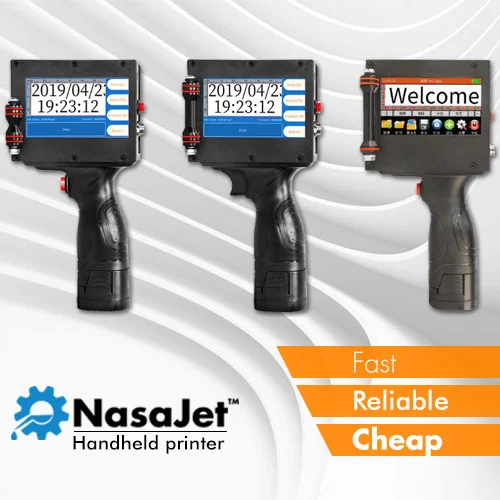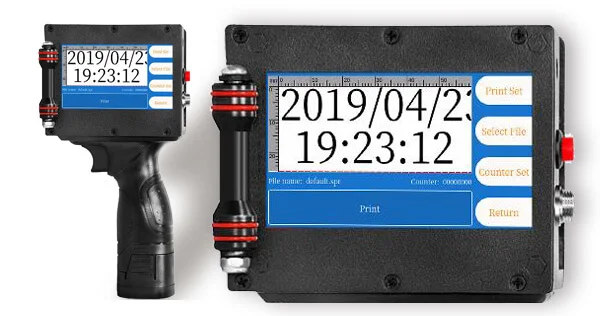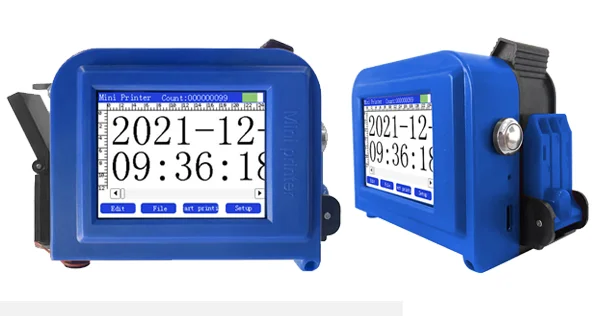-
Geotechtronics GmbH
Pollinger Str. 3 • D-82362 Weilheim i.OB -
Office hours
Mo-Sa: 9:00-18:00
With the NasaJet® handheld printer, mobile marking becomes simple, fast and economical.

Today, labelling, marking and identification are an integral part of the industrial manufacturing and distribution process. Legally required information such as expiry dates or serial numbers, but also logistically useful information such as batch numbers and shipping addresses are just some of the typical applications. Mobile labelling is being used more and more often because it expands the range of applications immensely. Labelling solutions that are permanently integrated into production lines can achieve very high throughput rates, but they have to be adjusted to the respective print object. With a handheld printer for mobile marking, the printing process becomes more flexible. Since the user determines the exact printing location, different objects can be printed one after the other without any problems, for example a shipping carton, pallet foiling and finally a delivery note. The hand printer also makes it easier to react to variations in the substrate to be printed on, such as the grain of wood or the unevenness of other natural materials like stone or metal. Even curves (tubes) or printing around edges is thus possible.
Mobile marking with TIJ systems
Thermal inkjet technologies (TIJ) have become the standard for industrial marking. Their advantages lie in their economical handling, the fact that they are largely maintenance-free and their robustness. Similar to conventional inkjet printing, the ink is "thrown" onto the substrate without contact. This enables very high processing speeds and prevents smearing of the printed images. The non-contact also prevents mechanical wear and tear. The entire printing process is based on electronic and thermal processes.
Ink for TIJ systems is available in a wide range of variants - water- and solvent-based. This results in a very wide variety of possible substrates for the printing process. There are also specialised inks for almost all substrates. This means that not only typical substrates such as cardboard or plastic can be marked, but also wood, stone, ceramics, metal, rubber and many more. There is also a wide range of inks for special applications, such as invisible UV inks or UV-curing inks that enable a controllable drying process.
Especially for mobile marking, TIJ technology allows a previously unattainable possibility for miniaturisation. Only the TIJ-typical combination of ink cartridge and print head made truly mobile devices possible, as the weight could thus be reduced to less than one kilogram.
Mobile marking with NasaJet® hand labellers
Our NasaJet® hand labellers allow effective and easy mobile marking of any product or object. Conventional TIJ printers have a print height of half an inch (approx. 12mmm). By combining several cartridges, specialised devices (such as the NJ-200) can achieve even greater print heights. With special 1 inch TIJ cartridges, print heights of 5cm or more are then possible (NJ-500).
The hand printers from NasaJet® are characterised by their low weight and robustness. The print templates are created directly in the device by input via the integrated touch screen. Everything that is needed in everyday industrial life is available in terms of possible output formats. In addition to text, numbers, dates or consecutive numbers, barcodes, QR codes and monochrome graphics (logos, banners) can of course also be output.
The devices are equipped with powerful, replaceable rechargeable batteries which, with their long runtime, also allow for longer use in shift work. This makes mobile marking practical and, with manageable costs, always economical.
Our hand labeller in action
Our hand-held marking device is suitable for marking almost all substrates and surfaces. The following videos show the NasaJet® in action.
The following YouTube videos set cookies as soon as they are clicked on. By clicking, you agree to the setting of cookies by YouTube.
















